I have been fermenting vegetables for about 10 years, but maybe longer. I just cannot recall. I learned the method from Wild Fermentations, the seminal book by Sandor Katz. His recipe is 5 pounds of cabbage and 3 tablespoons of salt. I rarely make a batch of 5 pounds at once, as I am the only person in my family eating these amazing fermented foods.
Here I share with you, my method, such as it is. I generally am attempting to use as little salt as possible and avoid using a brine (water and salt). I believe in letting the vegetables make their own “juice”. They did, in this instance, but I will also give you guidance, in case they don’t.
While some fermenters are very scientific about their ferments, I am not. I am more intuitive and playful but there are some rules.
- The first rule is that everything must be sterilized or very clean so that you don’t introduce any “bad,” unwanted bacteria.
- Related to this is, do not use antibacterial anything where you plan to ferment. You don’t want to wipe out the good bacteria.
- Wash your hands well, but be sure that you don’t have soap left on them.
- The vegetables or other food must be under the brine or liquid to keep things anaerobic – no air.
How to Make Fermented Vegetables
Jump to Printable InstructionsThe first step is to gather your ingredients and a non-reactive bowl. For me, it’s usually stainless steel.
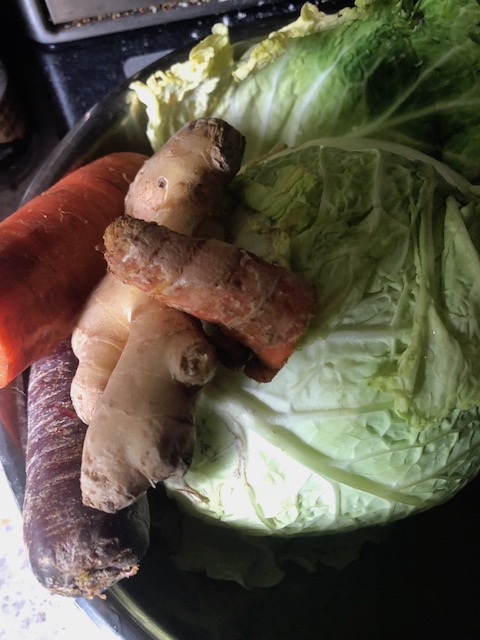
Cut the ingredients into the size and shape that you want. Here I am thinly slicing the cabbage, and doing the same with the ginger, turmeric (fresh root) and carrots. The only other ingredients are salt, love and time. But you can only buy the salt. I use regular, nothing fancy, sea salt.
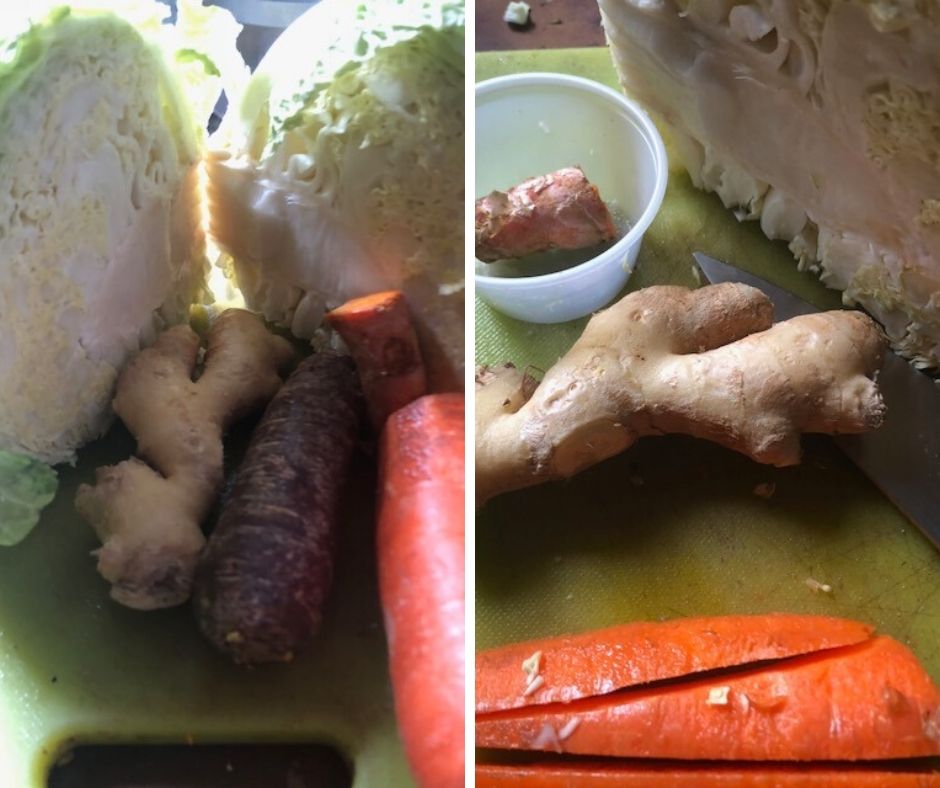
I cut up about half the cabbage and sprinkle with 1 teaspoon of salt. Then I add the other remaining cabbage and sprinkle with another teaspoon of salt.
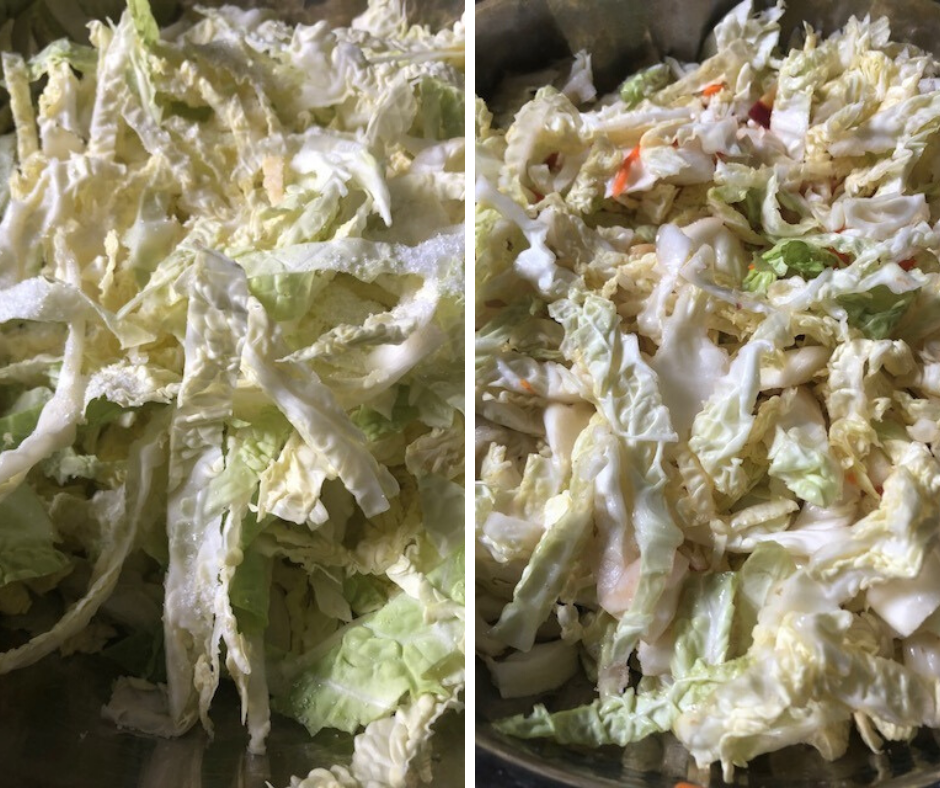
I add in the other ingredients, mix well with my hands or clean utensils (which in my case, are my hands). I cover with a dishcloth and let sit for 30 minutes to an hour or more. When you remove the cloth you want to see the cabbage looking a bit shiny and exuding some liquid. You can’t always tell until you get to the bottom of the bowl.
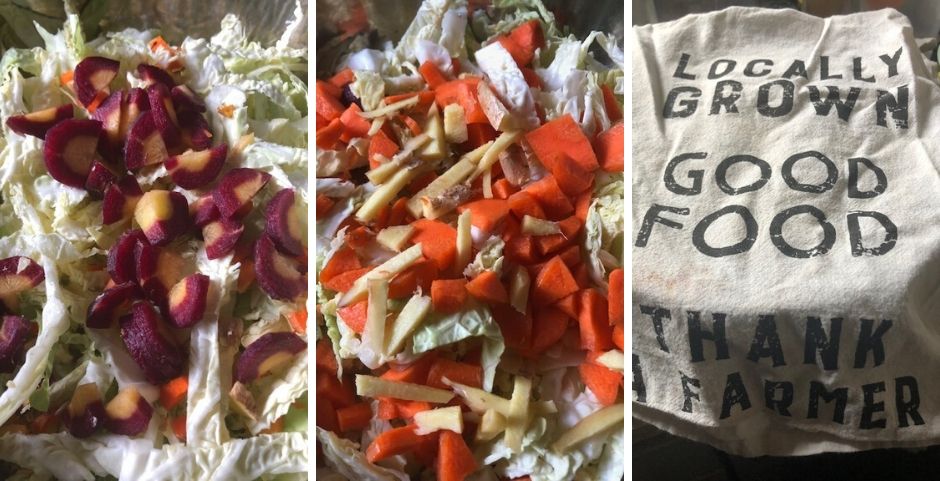
Then comes the fun part. Get a quart or liter jar and start stuffing the cabbage mixture into it. You can use a wooden spoon or tamper, or if you have small hands, like I do, your hands. Pack it really tight.
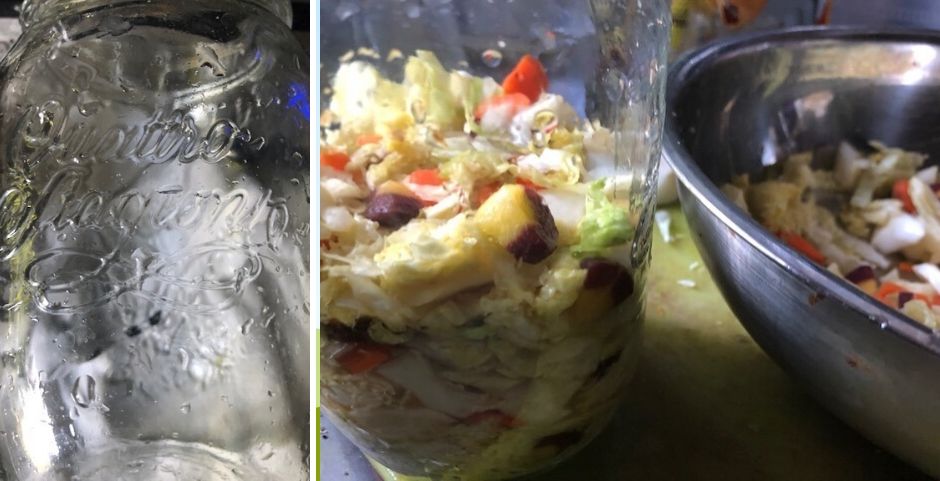
When everything is packed in, and you have added the liquid, from the bottom of the bowl, put a full cabbage leaf on top and press down firmly. Add the airlock lid (in this case silicone but there are many other kinds) and jar ring.
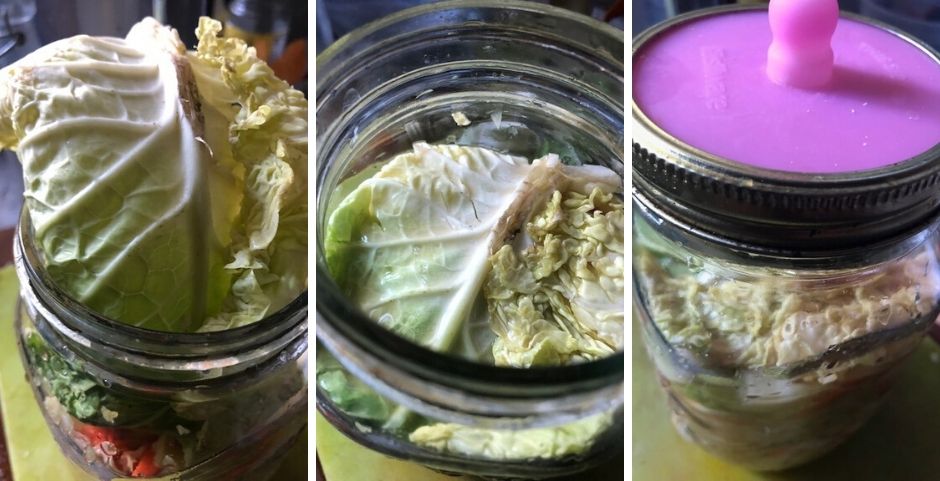
Put your jar in a cool, dark place for two to 3 weeks or more. If the jar is almost full, be sure to place the jar in a bowl, in case any of the liquid goes over the top. (Yes, this can happen during the fermentation.)
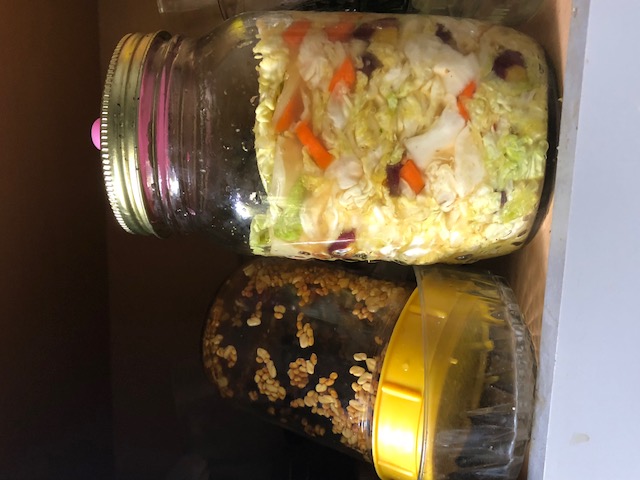
Note: if you do not end up with enough liquid to cover your ingredients, you need to add some brine, which is water mixed with salt. Use filtered, non-chlorinated water. Mix 1 teaspoon salt per cup of warm, heated water (or 2 teaspoons per pint) and let the salt dissolve and the mixture cool off. Then use that to top off the kraut mixture. This is a much higher salt ratio than what I use when mixing the vegetables so use it only if necessary. Often, waiting and squeezing will yield more liquid than you think possible.
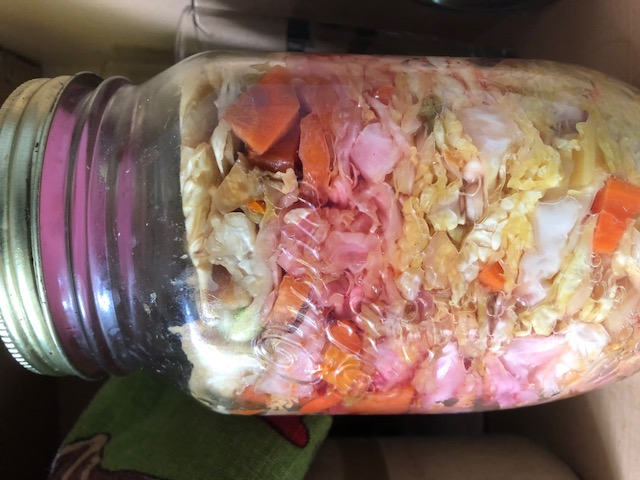
Once your jar is in the cool spot, you don’t have much work to do. Look at it once a week or so to be sure that there is no mold. After a week, you can taste your kraut, if you like, by removing your cabbage leaf lid and using a very clean utensil. The flavors continue to develop as you let your ferment go longer. It can continue fermenting for 2 to 3, or more weeks, depending upon the temperature of your environment. Longer, slower ferments have more flavor. Once it is to your liking, replace the air lock lid with a regular lid. I often put a piece of wax paper over the jar and then put on the full lid and ring.
There is much more to fermenting but I think that this will get you started.
Fermented Vegetables
1 head cabbage, of about 1 ½ to 2 pounds
1 to 2 tablespoons, sliced turmeric root (if available)
1 to 2 tablespoons organic ginger, sliced
1 to 2 carrots, peeled and sliced thin
2 to 3 teaspoons sea salt
Follow the instructions and add time and love…and you will have great results.
How to Make Fermented Vegetables
Materials
- 1 head cabbage of about 1 ½ to 2 pounds
- 1 to 2 tablespoons sliced turmeric root (if available)
- 1 to 2 tablespoons organic ginger sliced
- 1 to 2 carrots peeled and sliced thin
- 2 to 3 teaspoons sea salt
- Easy Fermenter Lid (https://amzn.to/34W0luG)
- Kraut Source Stainless Lid (https://amzn.to/2yEuZNi)
- Plastic Airlocks (https://amzn.to/3au46sr)
- Weights (https://amzn.to/2xQAAjn)
Instructions
- The first step is to gather your ingredients and a non-reactive bowl. For me, it’s usually stainless steel.
- Cut the ingredients into the size and shape that you want. Here I am thinly slicing the cabbage, and doing the same with the ginger, turmeric (fresh root) and carrots. The only other ingredients are salt, love and time. But you can only buy the salt. I use regular, nothing fancy, sea salt.
- I cut up about half the cabbage and sprinkle with 1 teaspoon of salt. Then I add the other remaining cabbage and sprinkle with another teaspoon of salt.
- I add in the other ingredients, mix well with my hands or clean utensils (which in my case, are my hands). I cover with a dishcloth and let sit for 30 minutes to an hour or more. When you remove the cloth you want to see the cabbage looking a bit shiny and exuding some liquid. You can’t always tell until you get to the bottom of the bowl.
- Then comes the fun part. Get a quart or liter jar and start stuffing the cabbage mixture into it. You can use a wooden spoon or tamper, or if you have small hands, like I do, your hands. Pack it really tight.
- When everything is packed in, and you have added the liquid, from the bottom of the bowl, put a full cabbage leaf on top and press down firmly. Add the airlock lid (in this case silicone but there are many other kinds) and jar ring.
- Put your jar in a cool, dark place for two to 3 weeks or more. If the jar is almost full, be sure to place the jar in a bowl, in case any of the liquid goes over the top. (Yes, this can happen during the fermentation.)
- Turn your head sideways as the jar is really standing upright. Next to it are the beginning of some sprouts.
- Once your jar is in the cool spot, you don’t have much work to do. Look at it once a week or so to be sure that there is no mold. After a week, you can taste your kraut, if you like, by removing your cabbage leaf lid and using a very clean utensil. The flavors continue to develop as you let your ferment go longer. It can continue fermenting for 2 to 3, or more weeks, depending upon the temperature of your environment. Longer, slower ferments have more flavor. Once it is to your liking, replace the air lock lid with a regular lid. I often put a piece of wax paper over the jar and then put on the full lid and ring. There is much more to fermenting but I think that this will get you started.
Notes
Regarding air locks, here are a few that I use:
Silicone https://amzn.to/3aBFkH7
Easy fermenter lid kit https://amzn.to/34W0luG
Kraut Source Stainless https://amzn.to/2yEuZNi
Plastic airlocks https://amzn.to/3au46sr
And if you need weights: https://amzn.to/2xQAAjn
Other Fermented Recipes You May Enjoy:
THE VEGGIE QUEEN’S NOT-YET-WORLD FAMOUS FERMENTILLAS: FERMENTED TORTILLAS
THE VEGGIE QUEEN MAKES OLD FASHIONED FERMENTED PICKLES
TIME TO MAKE FERMENTED SAUERKRAUT
What are your favorite things to ferment?
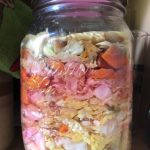
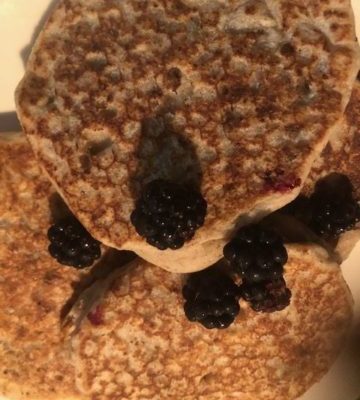
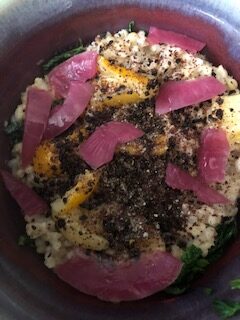
I have just started reading Wild Fermentation by Sandor Katz and loving it. Sally Fallon, in her introduction, said “Culture begins at the farm, not the opera house, and binds the people to a land and its artisans.” I am still such a novice yet this quote speaks to my heart. My experiments have been limited to cucumbers, onions, cauliflower and carrots plus your fermentillas. I am anxiously awaiting cooler weather here in NC so that I can try more “fragrant” mixtures and let them ferment in the garage. I can’t wait to try your sauerkraut recipe and all the good things awaiting me in Sandor’s book.
Very exciting. I love fermenting.
Oh, this recipe looks wonderful. Thank you, I would love to make it as soon as I can gather the ingredients. It is so good for the body.
You;re the only version of you.
Start where you are, use what you have.
Do what you can…….by Amy of Amy + Jacky – Pressure Cook Recipes.com
Take care.
I hope that you are able to find the ingredients as it is wonderful food.